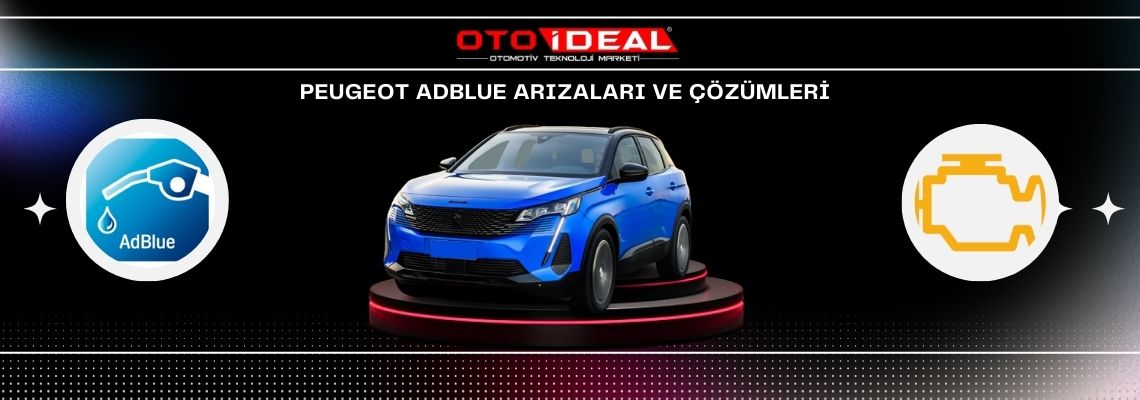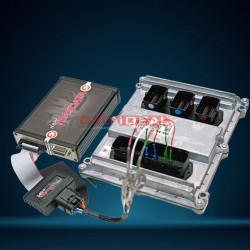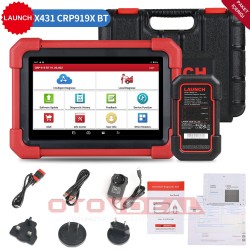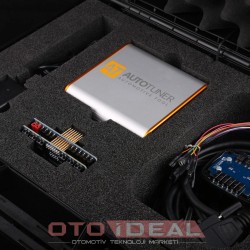
Peugeot AdBlue System Warning: What Should You Do?
If you encounter the "Check AdBlue System" warning in models like Peugeot 3008, 5008, 308, 508, 2008, Partner, or Expert, this usually indicates an issue with the vehicle's emissions control system. The most common cause of this warning is low AdBlue levels. However, this problem might not only be related to fluid levels. What causes AdBlue failures? Issues like faulty sensors within the AdBlue system, a problem with the SCR (Selective Catalytic Reduction) catalyst, or clogged AdBlue injectors can also trigger this warning. The first step is to check the AdBlue level and refill if necessary. If the problem persists, use an auto diagnostic tool to check the error codes in the system. This tool will identify the source of the malfunction and guide you to the correct solution. If this warning is not resolved, it could lead to more extensive system failures.
How to Turn Off the AdBlue Light?
The AdBlue warning light indicates a problem with the AdBlue system in your vehicle. This warning light typically illuminates due to low AdBlue fluid levels, but sometimes it can signal more complex issues. To avoid situations where the vehicle won’t start due to AdBlue failure, first, check the AdBlue level and refill it as needed. If the AdBlue light continues to stay on, there might be an issue with the quality of the fluid. Old or low-quality AdBlue fluid can prevent the system from functioning correctly. In this case, you may need to drain the fluid completely and refill it with fresh AdBlue. What does AdBlue system failure mean? It indicates an error in your vehicle's SCR system, which needs to be resolved. If you cannot turn off the light, try using an AdBlue system reset tool to reset the system. If the light still persists, a more severe fault may be present, and in that case, it would be best to take your vehicle to an authorized service center.
AdBlue Full But Still Showing Warning: Causes and Solution
If the AdBlue tank is full but the vehicle is still showing a warning, this usually indicates another issue within the system. These problems are often related to the poor quality of the AdBlue fluid or a fault in the SCR system. What causes AdBlue failures? AdBlue fluid crystallization or degradation can prevent the system from functioning properly. Additionally, sensor malfunctions within the system can also trigger such warnings. In this case, how to fix AdBlue failure? Start by draining the old fluid and refilling the tank with fresh, high-quality AdBlue. If this doesn’t resolve the issue, use an auto diagnostic tool to check the sensors and the SCR catalyst. Depending on the detected issues, you may need to have repairs done to clear the warning. If the warning persists, it could indicate a deeper mechanical problem that requires professional intervention.
How to Reset AdBlue in Peugeot Vehicles
Resetting the AdBlue system in Peugeot vehicles becomes crucial, especially if the AdBlue warning light continues to stay on. So, how do you perform an AdBlue reset in Peugeot vehicles? For this task, you can use the Peugeot Lexia 3 Diagbox software. This official diagnostic and repair software, developed for Peugeot and Citroën vehicles, allows you to recalibrate the AdBlue system by connecting to the vehicle's control unit.
Steps for AdBlue Reset Using Peugeot Lexia 3 Diagbox
- Install Peugeot Lexia 3 Diagbox Software: First, install the Peugeot Lexia 3 Diagbox software on your computer and ensure it is up to date. This software is the official diagnostic and repair tool developed for Peugeot vehicles.
- Connect the Vehicle: Connect your vehicle to the Peugeot Lexia 3 Diagbox system using an OBDII cable. This connection provides direct access to the vehicle's electronic control unit.
- Select the AdBlue System: Open the Peugeot Lexia 3 Diagbox software and select the AdBlue system from the menu. Here, you can view any existing errors in the system and initiate the necessary reset procedures.
- Start the Reset Process: Choose the "AdBlue Reset" option and follow the instructions. This process clears errors in the system and restores the AdBlue system to normal operation.
- Perform a Test Drive: After completing the reset, take your vehicle for a test drive to ensure the AdBlue system is functioning correctly. If the warning light reappears, a more thorough mechanical inspection may be needed.
By following these steps, you can easily reset the AdBlue system in your Peugeot vehicle. Make sure that the Peugeot Lexia 3 Diagbox software is up to date, and don't forget to take the necessary safety precautions during the process.
This procedure can help resolve existing issues with the AdBlue system and reset it. However, if the problem persists, you may need to seek professional service assistance.
Why Do DPF Failures Occur and How to Solve Them?
In Peugeot models such as the 3008, 5008, 308, 508, 2008, Partner, and Expert, the DPF (Diesel Particulate Filter) is a system designed to trap harmful particles from diesel engines and reduce emissions. However, over time, this filter can become clogged, leading to DPF failures. Why do DPF failures occur? Common causes include frequent short trips, using low-quality fuel, and not changing the engine oil on time. Short trips prevent the DPF from regenerating (self-cleaning), leading to increased deposits in the filter.
How to solve DPF failure? The first step is to initiate the DPF regeneration process by driving the vehicle at high speed for an extended period. This process helps burn off the accumulated particles, cleaning the DPF. If this method doesn’t work, professional cleaning or replacement of the DPF may be necessary. In some cases, you may need to use an auto diagnostic tool to clear error codes and manually start regeneration. If the DPF is completely clogged and cannot be cleaned, replacing the filter may be the best solution.
Why Do EGR Failures Occur and How to Solve Them?
In Peugeot models like the 3008, 5008, 308, 508, 2008, Partner, and Expert, the EGR (Exhaust Gas Recirculation) valve helps reduce emissions by recirculating a portion of the exhaust gases back into the combustion chamber. However, over time, the EGR valve can become clogged with carbon deposits, leading to failures. Why do EGR failures occur? The most common causes include using low-quality fuel, frequent short trips, and a lack of regular maintenance. These issues cause the valve to become clogged with carbon, preventing it from functioning correctly.
How to solve EGR failure? First, the EGR valve may need to be cleaned. A carbon cleaning process can remove the deposits in the EGR valve, allowing it to function correctly again. If the valve is severely clogged or damaged, it may need to be replaced. Use an auto diagnostic tool to check for error codes and assess the condition of the EGR valve. Proper functioning of the EGR system is crucial for controlling your vehicle's emissions, so it’s important to resolve any failures promptly.
What Are the AdBlue, DPF, and EGR Error Codes in Peugeot Vehicles?
In Peugeot vehicles, some common error codes related to the AdBlue, DPF (Diesel Particulate Filter), and EGR (Exhaust Gas Recirculation) systems that you might encounter with an auto diagnostic tool include:
AdBlue Error Codes
- P20E8: AdBlue pressure too low
- P20F6: AdBlue level sensor fault
- P2033: AdBlue heater malfunction
- P2047: AdBlue injector circuit fault
- P207F: SCR (Selective Catalytic Reduction) system efficiency low
- P2200: NOx sensor circuit fault (pre-sensor)
- P2202: NOx sensor circuit low (pre-sensor)
DPF Error Codes
- P2002: DPF efficiency low (particulate filter clogged)
- P242F: DPF overloaded
- P2453: DPF pressure sensor fault
- P2458: DPF regeneration duration too long
- P2463: DPF excessive particulate accumulation
EGR Error Codes
- P0400: EGR flow malfunction
- P0401: EGR flow insufficient
- P0402: EGR flow excessive
- P0403: EGR valve circuit fault
- P0404: EGR valve malfunction (excessive current)
- P0405: EGR sensor circuit low
- P0406: EGR sensor circuit high
These error codes indicate a problem within the vehicle's emissions control systems and can typically be detected using auto diagnostic tools. Each code points to a specific component or system issue, helping vehicle owners or technicians identify the root cause of the problem.
Proper diagnosis and timely repairs are essential to maintaining the vehicle's emissions performance and overall operational efficiency.


-75x75w.jpg)


-75x75w.jpg)










-75x75.jpg)





-75x75w.png)


-250x250.jpg)





Leave a Comment